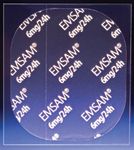There's a new patch to treat depression
Use of nonselective monoamine oxidase inhibitors (MAOIs) to treat depression has fallen from favor in recent years due to significant side effects and the development of newer agents with improved safety profiles.
TIPS TO REMEMBER
Emsam

One reason MAOIs have had limited appeal is their potential to cause a hypertensive crisis if tyramine is ingested during MAOI treatment. This is thought to be due to the MAOI's inhibition of MAO-A in the gastrointestinal tract. MAO-A is the enzyme normally responsible for the breakdown of tyramine, a precursor to norepinephrine. Tyramine is found in a number of foods and alcoholic beverages.
"Selegiline is a selective inhibitor of MAO-B that is found in the brain," said Susan Sonne, Pharm.D., BCPP, associate professor of psychiatry and pharmacy at Medical University of South Carolina. At higher doses, however, it will also inhibit MAO-A, making the tyramine issue a continuing problem. "With the development of the transdermal system, selegiline bypasses the GI tract and there is less inhibition of MAO-A and less need for dietary restrictions of tyramine."

Sonne believes the transdermal form of selegiline may be useful for those who have benefited from MAOIs but cannot tolerate the dietary restrictions. "Also, there may be fewer side effects associated with this dosage form because there is less of a peak effect."
Despite the improvements, labeling for the new patch is laden with potential adverse events and other considerations. Like other antidepressants, it also contains a "black box" warning of the increased risk of suicidal thinking and behavior in children and adolescents.
"This is an agent that was very well tolerated in clinical trials with good efficacy," said Stephen R. Saklad, Pharm.D., BCPP, clinical associate professor, University of Texas College of Pharmacy. "Since many patients do not do well on our conventional treatments, this is an attractive alternative to consider."
The recommended starting dose of the selegiline patch is one 6 mg/24 hr patch applied once daily; it is also available in strengths of 9 mg/24 hr and 12 mg/24 hr. While tyramine restrictions are not required with the 6 mg/24 hr patch, patients should be informed that tyramine-rich foods should be avoided while using and after discontinuation of the 9-mg and 12-mg patches and following a dosage reduction to the 6-mg strength, for a period of two weeks. The recommended dose for patients 65 years or older is 6 mg/24 hr. Elderly patients should also be closely monitored for postural changes in blood pressure during treatment.
Targeted Drug Combination Reveals New Activity in Brain Tumors
December 28th 2021A combination of two targeted cancer drugs showed unprecedented, “clinically meaningful” activity in patients with highly malignant brain tumors that carried a rare genetic mutation, according to a clinical trial report by investigators from Dana-Farber Cancer Institute.